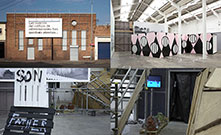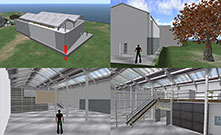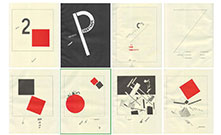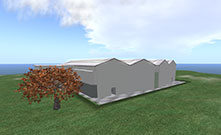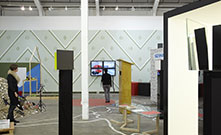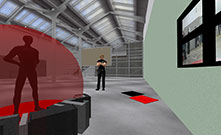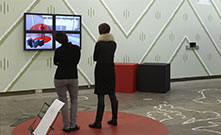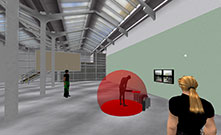Data Double (El Lissitzky iteration)
v1.0 by: Michael Takeo Magruder, 2009
A shared portal between reality and virtuality based upon El Lissitzky's notion of architectural space as artwork.
About the Artwork:
Data Double (El Lissitzky iteration) is a mixed-reality installation that acts as a two-way, digital mirror between reality and virtuality, enabling viewers in each 'world' to gaze upon remediations of themselves and their surrounding space. Reflecting back to us our spatial environments, while simultaneously disrupting and distorting our perceptions of them, the artwork seeks to facilitate new creative and curatorial possibilities between the paralleled worlds, exploring relationships and opening dialogical spaces between the real and the virtual, the actual and the imagined.
The artwork is conceptually based upon the work of Russian artist and theorist El Lissitzky and his notion of architectural space as artwork, which he demonstrated through his Abstract Cabinet rooms of 1926-28. The installation is formally derived from Lissitzky's page design From far away, flying towards the Earth taken from his seminal publication About 2 Squares (Sycthian Press, Berlin, 1922) in which he proposes the translation of constructed forms across realities in a manner that expands their spatial and temporal qualities as they shift between worlds.
Simultaneously located within the physical environment of Eastside Projects and its shared virtual counterpart in Second Life, the artwork extends Lissitzky's illustration across the real and virtual spaces as balancing opposites. Within the physical gallery, Lissitzky's two squares expand into perfect cubes, while the earth and cityscape (red circle and surrounding black forms) remain 'flat' as floor-painted elements. In the virtual realm, by contrast, the squares revert to planes and the planet-city complex acquires a third dimension.
The 'mirror' interface between the worlds is realised through a pair of live, bi-directional, audiovisual transmissions that allow both virtual and physical spectators to be aware of one another and their surroundings. The reflection of the virtual environment displayed on the video wall within the physical gallery is generated through the space's black doll (a virtual body devoid of human agency that is used to 'sense' and transmit aspects of a virtual world). Within Second Life, the opposing view of the physical environment is provided by an IP camera that streams live video of the actual location across the Internet to its virtual counterpart. In addition, a motion sensor tracks visitor movement within the real space, and transmits its live data to the virtual realm. When an individual enters the red circular area of the installation, the doll comes to life and shifts its gaze back towards the onlooking spectator.
Materials:
Virtual: mirrored gallery space, constructed elements, video stream, (avatar) Doll and scripted control units.
Physical: 4 monitor LCD video wall, computer, motion sensor, 2 fabricated cubes (75cm.3) and floor painting.
Virtual/Physical Documentation:
Experience Version 1.0:
Virtual: 26 September to 8 November 2009, Transitional Space, Second Life: A Windows/Mac/Linux computer system running the current Second Life client is required to visit the shared virtual environment. A high-specification CPU/GPU, 5.1 or stereo audio, a colour display with ≥1024x768 resolution and a 1Mbps+ Internet connection are recommended.
Physical: 26 September to 8 November 2009, Eastside Projects, Birmingham, UK: Visit the shared physical environment as part of the Abstract Cabinet Show, Thursday (12-7pm), Friday to Sunday (12-5pm).
With Thanks to:
Gavin Wade [ curation ] . Drew Baker (as 'Melancholy Graves') [ Second Life modelling & scripting ] . Simon Bloor [ floor painting ] . Gregory Sporton [ infrastructure ] . Robin Kirkham [ maintenance ] . Hugh Denard [ discourse ]
Supported by:
Data Double (El Lissitzky iteration) is an experimental prototype for EP:VV (Eastside Projects: Virtualised and Visualised) – an initiative seeking to develop online, multi-user environments promoting new models of artistic participation and representation within a gallery context. EP:VV is a collaboration between Eastside Projects, the Visualisation Research Unit, Birmingham City University and King’s Visualisation Lab, King’s College London, made possible through funding by Arts Council England.
Artwork Requirements:
Virtual: Windows/Mac/Linux computer system with the current Second Life client and stereo audio. A high-specification CPU/GPU, colour display with ≥1024x768 resolution and high-speed Internet connection are recommended.
Physical: 4 monitor LCD video wall, computer (with the Second Life client), custom-built motion sensor, 2 fabricated cubes (75cm.3) and floor painting.
